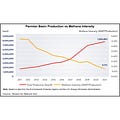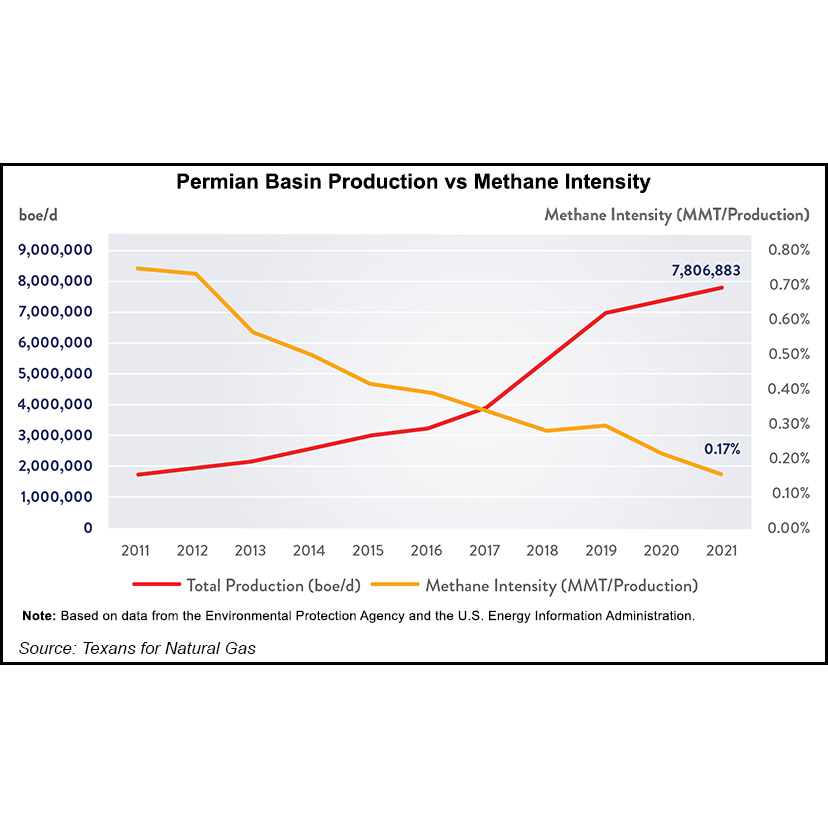U.S. Flaring Declines to ‘Volumes Not Seen in Over a Decade,’ Says Texans for Natural Gas Report
The Green NGO’s never seem to find Reports from the other side, aka loyal opposition.
U.S. Flaring Declines to ‘Volumes Not Seen in Over a Decade,’ Says Texans for Natural Gas Report
BY MORGAN EVANS. December 22, 2022
As oil and natural gas output from the Permian Basin has soared 345% from 2011-2020, methane intensity in the basin has fallen more than 76%, according to Texans for Natural Gas (TNG), a campaign run by the Texas Independent Producers and Royalty Owners Association (TIPRO).
In its third annual report, titled Permian Basin Producers: Chartering a Cleaner Energy Future, TNG found that in 2021, methane intensity – aka the amount of methane released in carbon dioxide equivalent (CO2e) for every barrel of oil equivalent produced – reached its lowest levels in a decade of about 0.17% after falling 20% year/year in the Permian Basin.
“Texas’ role as a global energy leader extends well beyond just volumes,” said TIPRO President Ed Longanecker. “Our state, and the Permian specifically, produces some of the world’s cleanest natural gas.”
TNG is managed by TIPRO, which represents about 3,000 Texas independent oil and natural gas producers and royalty owners.
According to the report, flaring intensity in the Permian also dropped significantly last year, plunging 34% y/y. Flaring intensity, or the amount of gas flared for every barrel of oil equivalent produced, fell 60% over the same period across the Lone Star State.
As for the United States, flaring fell to “volumes not seen in over a decade,” according to TNG. In 2021, U.S. flaring fell to 8.76 Bcm, down by about 50% from the 2019 peak of 17.29 Bcm.
By comparison, TNG said Russia led the world in flared volumes, estimating the country burned off more than 25 Bcm of natural gas last year. After Russia, Iraq and Iran, the United States is listed as No. 4 in terms of flared volumes from 2017-2021.
If Texas were its own country, it would come in at No. 10, with the Permian Basin at No. 13 in flared volumes, after China and Oman.
The Permian and Texas producing comparatively clean natural gas “…matters more than ever today, as global unrest is creating energy challenges everywhere,” Longanecker said. “We have what it takes to power the homes, businesses and industries of Americans and our allies. Leaders at home and abroad should take note of the progress Texas producers have made in methane and flaring intensity as they develop policies impacting our industry.”
Meanwhile, the Environmental Protection Agency, from which TNG gathered some of the data for its report, projects that in 2030, the energy sector may be the third largest contributing sector to non-CO2 greenhouse gas (GHG) emissions, with Texas leading the U.S. in methane and nitrous oxide emissions.
The agency estimates that by 2030, GHG emissions could sit around 285 metric tons of CO2e, with natural gas and oil activities remaining as the largest contributor to non-CO2 emissions. TNG noted in its report that there are several organizations working in Texas and across the Lower 48 to reduce methane emissions. Some initiatives include the Oil and Gas Methane Partnership 2.0, the Texas Methane and Flaring Coalition, the World Bank’s Zero Routine Flaring pledge, the Environmental Partnership and the Oil and Gas Climate Initiative.
© 2022 Natural Gas Intelligence. All rights reserved.






